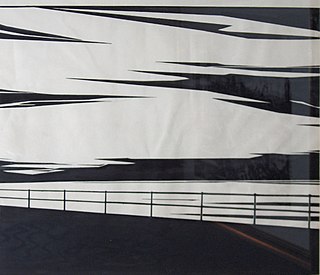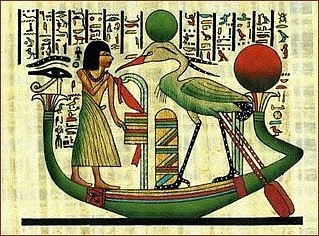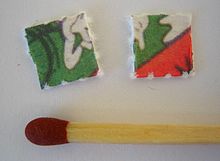
Lysergic acid diethylamide, commonly known as LSD, and known colloquially as acid or lucy, is a potent psychedelic drug. Effects typically include intensified thoughts, emotions, and sensory perception. At sufficiently high dosages, LSD manifests primarily mental, visual, and auditory hallucinations. Dilated pupils, increased blood pressure, and increased body temperature are typical.

Monotyping is a type of printmaking made by drawing or painting on a smooth, non-absorbent surface. The surface, or matrix, was historically a copper etching plate, but in contemporary work it can vary from zinc or glass to acrylic glass. The image is then transferred onto a paper by pressing the two together, using a printing-press, brayer, baren or by techniques such as rubbing with the back of a wooden spoon or the fingers which allow pressure to be controlled selectively. Monotypes can also be created by inking an entire surface and then, using brushes or rags, removing ink to create a subtractive image, e.g. creating lights from a field of opaque colour. The inks used may be oil or water-based. With oil-based inks, the paper may be dry, in which case the image has more contrast, or the paper may be damp, in which case the image has a 10 percent greater range of tones.

Watercolor or watercolour, also aquarelle, is a painting method in which the paints are made of pigments suspended in a water-based solution. Watercolor refers to both the medium and the resulting artwork. Aquarelles painted with water-soluble colored ink instead of modern water colors are called aquarellum atramento by experts. However, this term has now tended to pass out of use.

A marker pen, fine liner, marking pen, felt-tip pen, felt pen, flowmarker, sign pen, vivid, flomaster, texta, sketch pen, koki or simply marker is a pen which has its own ink source and a tip made of porous, pressed fibers such as felt. A marker pen consists of a container and a core of an absorbent material that holds the ink. The upper part of the marker contains the nib that was made in earlier times of a hard felt material, and a cap to prevent the marker from drying out.
Sizing or size is a substance that is applied to, or incorporated into, other materials—especially papers and textiles—to act as a protective filler or glaze. Sizing is used in papermaking and textile manufacturing to change the absorption and wear characteristics of those materials.

William Leonard Pickard is one of two people convicted in the largest lysergic acid diethylamide (LSD) manufacturing case in history. In 2000, while moving their LSD laboratory across Kansas, Pickard and Clyde Apperson were pulled over while driving a Ryder rental truck and a follow car. The laboratory had been stored near a renovated Atlas-E missile silo near Wamego, Kansas. Gordon Todd Skinner, one of the men intimately involved in the case but not charged due to his cooperation, owned the property where the laboratory equipment was stored.

Psychedelic art is art, graphics or visual displays related to or inspired by psychedelic experiences and hallucinations known to follow the ingestion of psychedelic drugs such as LSD, psilocybin, and DMT. The word "psychedelic" means "mind manifesting". By that definition, all artistic efforts to depict the inner world of the psyche may be considered "psychedelic".
A writing implement or writing instrument is an object used to produce writing. Writing consists of different figures, lines, and or forms. Most of these items can be also used for other functions such as painting, drawing and technical drawing, but writing instruments generally have the ordinary requirement to create a smooth, controllable line.

2,5-Dimethoxy-4-chloroamphetamine (DOC) is a psychedelic drug of the phenethylamine and amphetamine chemical classes. It was presumably first synthesized by Alexander Shulgin, and was described in his book PiHKAL.

Inkjet paper is a special fine paper designed for inkjet printers, typically classified by its weight, brightness and smoothness, and sometimes by its opacity.

Paper is a thin sheet material produced by mechanically or chemically processing cellulose fibres derived from wood, rags, grasses, or other vegetable sources in water, draining the water through a fine mesh leaving the fibre evenly distributed on the surface, followed by pressing and drying. Although paper was originally made in single sheets by hand, almost all is now made on large machines—some making reels 10 metres wide, running at 2,000 metres per minute and up to 600,000 tonnes a year. It is a versatile material with many uses, including printing, painting, graphics, signage, design, packaging, decorating, writing, and cleaning. It may also be used as filter paper, wallpaper, book endpaper, conservation paper, laminated worktops, toilet tissue, currency, and security paper, or in a number of industrial and construction processes.

India ink is a simple black or coloured ink once widely used for writing and printing and now more commonly used for drawing and outlining, especially when inking comic books and comic strips. India ink is also used in medical applications.
Whatman plc is a Cytiva brand specialising in laboratory filtration products and separation technologies.

25I-NBOMe is a novel synthetic psychoactive substance with strong hallucinogenic properties, synthesized in 2003 for research purposes. Since 2010, it has circulated in the recreational drug scene, often misrepresented as LSD. The recreational usage of 25I is associated with severe intoxication and deaths in humans.

25C-NBOMe is a psychedelic drug and derivative of the psychedelic phenethylamine 2C-C. 25C-NBOMe appeared on online vendor sites in 2010 but was not reported in the literature until 2011. It acts as a potent agonist of the 5-HT2A receptor, and has been studied in its 11C radiolabelled form as a potential ligand for mapping the distribution of 5-HT2A receptors in the brain, using positron emission tomography (PET). Multiple deaths have occurred from usage of 25C-NBOMe due to the ease of accidental overdose. The long-term toxic effects of the drug have not been researched.

Parchment craft, also known as Pergamano, is the art of embellishing and decorating parchment paper through the use of techniques such as embossing, perforating, stippling, cutting and coloring.

Watercolor paper is paper or substrate onto which an artist applies watercolor paints, pigments, or dyes. Many types of watercolour papers that are manufactured for the use of watercolors are currently available. Watercolor paper can be made of wood pulp exclusively, or mixed with cotton fibers. Pure cotton watercolor paper is also used by artists, though it typically costs more than pulp-based paper. It is also available as an acid-free medium to help its preservation.

Blotter art is an art form printed on perforated sheets of absorbent blotting paper infused with liquid LSD. The delivery method gained popularity following the banning of the hallucinogen LSD in the late 1960s. The use of graphics on blotter sheets originated as an underground art form in the early 1970s, sometimes to help identify the dosage, maker, or batch of LSD.


















